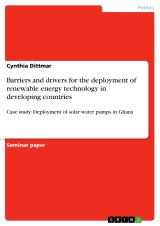Details

Barriers and drivers for the deployment of renewable energy technology in developing countries
Case study: Deployment of solar water pumps in Ghana1. Auflage
|
CHF 15.00 |
|
| Verlag: | Grin Verlag |
| Format: | EPUB, PDF |
| Veröffentl.: | 20.07.2009 |
| ISBN/EAN: | 9783640378166 |
| Sprache: | englisch |
| Anzahl Seiten: | 14 |
Dieses eBook erhalten Sie ohne Kopierschutz.
Beschreibungen
Seminar paper from the year 2008 in the subject Politics - International Politics - Topic: Development Politics, grade: merit, University of Manchester (Institute for Development Policy and Management), course: Environment and Development, language: English, abstract: Renewable energy technology (RET) are considered as “one of the strong contenders to improve plight” (Painuly 2001: 73) for more than 2 billion people in developing coun-tries who don’t have access to the clean modern energy which is essential to social and economic development (BMZ 2006). RET are increasingly recognised for their contri-bution to development especially in rural areas, increasing health, energy independence and climate change mitigation.
Due to massive technological improvements in recent years, economies of scale in pro-duction and given the absence of market distortions , RET can be cost competitive with conventional energy sources. This counts especially for off-grid RET in rural and remote areas where costs for grid connection are excessively expensive and where 80% of people without access to electricity live. RET become even more competitive if environmental externalities are factored into the market price of competing fuels (Martinot et al. 2002). Despite those advantages, RET in developing and developed countries are only tapped to a small amount of their potential as there are several types of barriers to their deployment (Painuly 2001). While traditional renewable energy sources like bio-mass (i.e. fuel wood, animal wastes and crop residues) provide 30 - 45% of the energy supply in developing countries (up to 90 % in rural Sub-Sahara-Africa) RET produce only about 2 % of the global energy supply, mostly in developed countries (REN21 2005).
This paper aims to identify major drivers and barriers to the deployment of renewable energy technology in developing countries. In chapter two the main drivers for RET, as well as their ability to contribute to development aims and poverty reduction, will be discussed in general, as there are a number of incentives for developing as well as de-veloped countries. Barriers, however, depend more on the particular technology and conditions in countries or regions (Martinot et al. 2002). The second part of this paper will look at a specific case study: The deployment of solar water pumps in Ghana.
[...]
Due to massive technological improvements in recent years, economies of scale in pro-duction and given the absence of market distortions , RET can be cost competitive with conventional energy sources. This counts especially for off-grid RET in rural and remote areas where costs for grid connection are excessively expensive and where 80% of people without access to electricity live. RET become even more competitive if environmental externalities are factored into the market price of competing fuels (Martinot et al. 2002). Despite those advantages, RET in developing and developed countries are only tapped to a small amount of their potential as there are several types of barriers to their deployment (Painuly 2001). While traditional renewable energy sources like bio-mass (i.e. fuel wood, animal wastes and crop residues) provide 30 - 45% of the energy supply in developing countries (up to 90 % in rural Sub-Sahara-Africa) RET produce only about 2 % of the global energy supply, mostly in developed countries (REN21 2005).
This paper aims to identify major drivers and barriers to the deployment of renewable energy technology in developing countries. In chapter two the main drivers for RET, as well as their ability to contribute to development aims and poverty reduction, will be discussed in general, as there are a number of incentives for developing as well as de-veloped countries. Barriers, however, depend more on the particular technology and conditions in countries or regions (Martinot et al. 2002). The second part of this paper will look at a specific case study: The deployment of solar water pumps in Ghana.
[...]
Diese Produkte könnten Sie auch interessieren:

The The Longest Boundary: How the US-Canadian Border's Line came to be where it is, 1763-1910 (Consolidated edition)

von: John Dunbabin

CHF 18.20
















